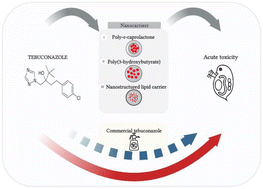Effects of three tebuconazole nanopesticides on the survival of Daphnia magna†
Abstract
The growing pressure to reduce excessive pesticide use has led to exploring novel formulation methods, including nanoparticle carriers for active substances. However, these emerging nanopesticides need a thorough evaluation compared to current formulations to determine whether their “nano” properties intensify toxicity for non-target organisms. This study assessed the lethal toxicity of three nanopesticides on Daphnia magna. The nanopesticides tested were tebuconazole loaded onto poly-ε-caprolactone, nanostructured lipid carriers, and poly(3-hydroxybutyrate) nanoparticles. Additionally, the study evaluated the toxicity of nanocarriers without loaded tebuconazole, a commercial tebuconazole formulation, and tebuconazole (pure). Effects were studied across a series of dilutions to examine the impacts on tebuconazole chemistry (total and free concentrations) and particle physics (size, heterogeneity, and density). D. magna exhibited varied responses to polymeric and lipid nanoformulations of tebuconazole and unloaded nanocarriers. The observed toxicity levels, from highest to lowest, were as follows: pure tebuconazole > tebuconazole-loaded on nanostructured lipid carriers > commercial tebuconazole > tebuconazole-loaded on poly(3-hydroxybutyrate) nanoparticles > tebuconazole-loaded on poly-ε-caprolactone. The mechanisms underlying the observed toxicity can generally be attributed to chemical factors (tebuconazole's free concentration and particle composition) and physical aspects (particle size and concentration). The study also revealed that dilution series can influence particle size and homogeneity, affecting the loaded substance's chemistry. This implies that the toxicity testing of nanopesticides is complex and not as straightforward as traditional dose–response modeling. Research like this is crucial to understanding the ecological impacts of nanopesticides, ensuring that new nanoformulations are beneficial rather than detrimental for plant protection.



 Please wait while we load your content...
Please wait while we load your content...